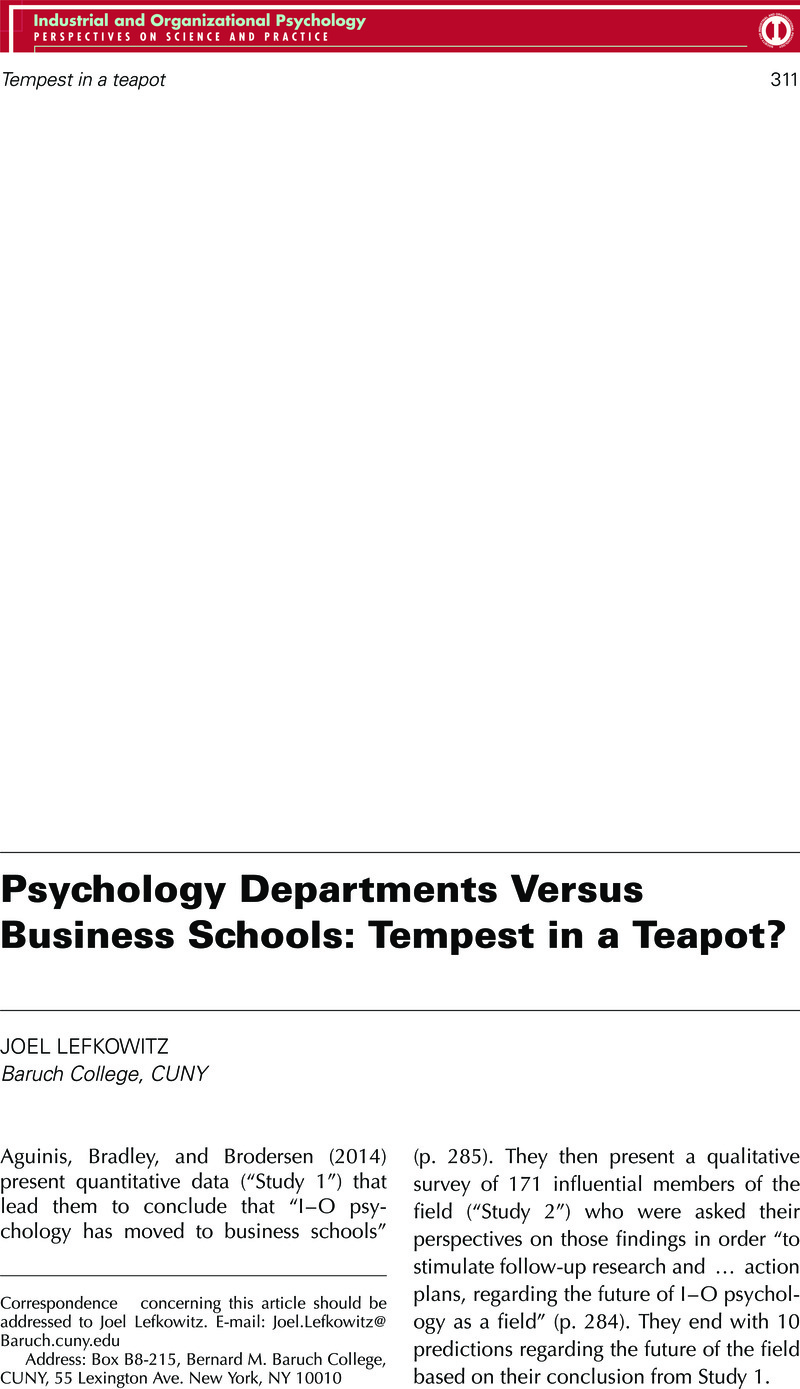No CrossRef data available.
Article contents
Psychology Departments Versus Business Schools: Tempest in a Teapot?
Published online by Cambridge University Press: 07 January 2015
Abstract
An abstract is not available for this content so a preview has been provided. Please use the Get access link above for information on how to access this content.

- Type
- Commentaries
- Information
- Copyright
- Copyright © Society for Industrial and Organizational Psychology 2014
References
Aguinis, H., Bradley, K. J., & Brodersen, A. (2014). Industrial–organizational psychologists in business schools: Brain drain or eye opener? Industrial and Organizational Psychology: Perspectives on Science and Practice, 7(3), 284–303.Google Scholar
Byrne, Z. S., Hayes, T. L., McPhail, S. M., Hakel, M. D., Cortina, J. M., & McHenry, J. J. (2014). Educating industrial–organizational psychologists for science and practice: Where do we go from here? Industrial and Organizational Psychology: Perspectives on Science and Practice, 7(1), 2–14.Google Scholar
Gasser, M., Butler, A., Waddilove, L., & Tan, R. (2004). Defining the profession of industrial-organizational psychology. The Industrial-Organizational Psychologist, 42(2), 15–20.Google Scholar
Highhouse, S., & Zickar, M. J. (1997). Where has all the psychology gone? The Industrial-Organizational Psychologist. Retrieved from http://www.siop.org/tip/backissues/tipoct97/HIGHHO∼1.aspxGoogle Scholar
Klein, K. J., & Kozlowski, S. W. J. (Eds.) (2000). Multilevel theory, research and methods in organizations: Foundations, extensions and new directions. San Francisco, CA: Jossey Bass.Google Scholar
Lawler, E. E., Cranny, C. J., Campbell, J. P., Schneider, B., MacKinney, A. C., & Vroom, V. H. (1971). The changing role of industrial psychology in university education: A symposium. Professional Psychology, 2(1), 2–22.Google Scholar
Lefkowitz, J. (2003). Ethics and values in industrial-organizational psychology. Mahwah, NJ: Erlbaum.CrossRefGoogle Scholar
Lefkowitz, J. (2005). The values of industrial-organizational psychology: Who are we? The Industrial-Organizational Psychologist, 43(2), 13–20.Google Scholar
Lefkowitz, J. (2008). To prosper, organizational psychology should…expand its values to match the quality of its ethics. Journal of Organizational Behavior, 29, 439–453.CrossRefGoogle Scholar
Lefkowitz, J. (2010). Industrial-organizational psychology's recurring identity crises: It's a values issue! Industrial and Organizational Psychology: Perspectives on Science and Practice, 3(3), 293–299.Google Scholar
Lefkowitz, J. (2011). The science, practice, and morality of work psychology. Industrial and Organizational Psychology: Perspectives on Science and Practice, 4(1), 112–115.CrossRefGoogle Scholar
Lefkowitz, J. (2014). Educating industrial-organizational psychologists for science, practice and social responsibility. Industrial and Organizational Psychology: Perspectives on Science and Practice, 7(1), 38–44.Google Scholar
Lombardi, W. J., Higgins, E. T., & Bargh, J. A. (1987). The role of consciousness in priming effects on categorization: Assimilation versus contrast as a function of awareness of the priming task. Personality and Social Psychology Bulletin, 13(3), 411–429.Google Scholar
Murphy, S. T., & Zajonc, R. B. (1993). Affect, cognition, and awareness: Affective priming with optimal and suboptimal stimulus exposures. Journal of Personality and Social Psychology, 64(5), 723–739.CrossRefGoogle ScholarPubMed
Pugh, D. S. (1966). Modern organizational theory: A psychological and sociological study. Psychological Bulletin, 66, 235–251.Google Scholar
Pugh, D. S. (1969). Organizational behaviour: An approach from psychology. Human Relations, 22, 345–354.Google Scholar
Ryan, A. M. (2003). Defining ourselves: I-O psychology's identity quest. The Industrial-Organizational Psychologist, 41(1), 21–33.Google Scholar
Ryan, A. M., & Ford, J. K. (2010). Organizational psychology and the tipping point of professional identity. Industrial and Organizational Psychology: Perspectives on Science and Practice, 3, 241–258.Google Scholar
Steiner, A., & Yancey, G. B. (2013). The knowledge and skills employers desire when hiring an I-O psychologist. The Industrial-Organizational Psychologist, 51(1), 53–60.Google Scholar
U.S. Bureau of Labor Statistics. (2014). Fastest growing occupations. Occupational outlook handbook. Retrieved from http://www.bls.gov/ooh/print/fastest-growing.htmGoogle Scholar
Zickar, M. J., & Highhouse, S. (2001). Measuring prestige of journals in industrial-organizational psychology. The Industrial-Organizational Psychologist, 38(4). Retrieved from http://www.siop.org/tip/backissues/TipApr01/03Zicker.aspxGoogle Scholar




